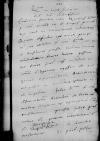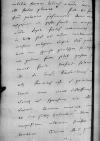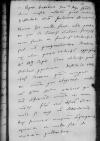Nuntius Reverendissimae Paternitatis Vestrae incidit in id tempus, quando ⌊rex⌋ erat in venationes abiturus. Quare difficulter ego written over i⌈ioo written over i⌉ omnia peregi tamen, quae volebat Dominatio Vestra Reverendissima, cui et ⌊dominis consiliariis Prussiae⌋ studium meum commendatum facere laboro. Possum hoc dicere, quod nisi industrie et summa diligentia egissem, ista, quae spectant confirmationem articulorum, res fuisset in conventum extracta et ibi impedita. Habet Reverendissima Dominatio Vestra confirmationem articulorum de verbo ad verbum scriptam ex exemplari ⌊dominorum consiliariorum Prussiae⌋, habet, quod voluit, de pecunia contributionis, de vexilliferatu superinscribed in place of crossed-out gladiferatu⌈gladiferatuvexilliferatuvexilliferatu superinscribed in place of crossed-out gladiferatu⌉, de conventus translatione. Si quid posthac  BCz, 1597, p. 140 iubebit, fac<i>am lubens omnia, nam illi studeo placere.
BCz, 1597, p. 140 iubebit, fac<i>am lubens omnia, nam illi studeo placere.
Fuit hic famulus hidden by binding⌈[ulus]ulus hidden by binding⌉ domini ⌊palatini Posnaniensis⌋, qui verbis hidden by binding⌈[bis]bis hidden by binding⌉ exposuit, ut gesta sunt in ⌊Eniponte hidden by binding⌈[te]te hidden by binding⌉⌋ omnia. Dixit factas caeremonias i[...] hidden by binding⌈[...][...] hidden by binding⌉ in lecto, sed ad talum tantummodo [...] hidden by binding⌈[...][...] hidden by binding⌉ incisam caligam dixit domino palatino, qui hidden by binding⌈[ino, qui]ino, qui hidden by binding⌉ lecto cum sponsa paulisper se deposuit hidden by binding⌈[uit]uit hidden by binding⌉, ut ⌊Gedani⌋ fieri solet, postea s[...] hidden by binding⌈[...][...] hidden by binding⌉tiones factae. Praefuit sollemnitati hidden by binding⌈[itati]itati hidden by binding⌉ illi dominus ⌊cardinalis Tridentinus⌋ et alii. Tractatus(?) est ⌊dominus palatinus⌋ [...] hidden by binding⌈[...][...] hidden by binding⌉tante or lante or laute⌈tantetante or lante or laute⌉, cum vero discessurus erat hidden by binding⌈[erat]erat hidden by binding⌉, venit ad ⌊sponsam⌋, ut illi vale hidden by binding⌈[vale]vale hidden by binding⌉diceret. Quam invenit ornatam hidden by binding⌈[atam]atam hidden by binding⌉ et duo serta habentem, alterum impositum, alterum sinistra manu hidden by binding⌈[anu]anu hidden by binding⌉ tentum. Quorum illud, quod hidden by binding⌈[d]d hidden by binding⌉  BCz, 1597, p. 141 in capite habebat, serenissimo ⌊regi sponso⌋ dono misit, alterum, quod manu gestabat, domino ⌊palatino⌋ donavit.
BCz, 1597, p. 141 in capite habebat, serenissimo ⌊regi sponso⌋ dono misit, alterum, quod manu gestabat, domino ⌊palatino⌋ donavit.
Nova hic nulla sunt alia praeter ea, quae de ⌊Turcis ⌋dudum scripsi. Iam sunt in finibus ⌊Valachiae⌋, sed non progrediuntur. ⌊Tartari⌋ ex alia parte Valachum oppugnant. Regiae maiestatis capit(aneus) or capit(alis)⌈capit(aneus)capit(aneus) or capit(alis)⌉(?) cum Valacho pacem stabilivit perpetuam. Restituit Valachus terram, quam occuparat, et omnia, quae abegerat. Mittit ad ⌊regiam maiestatem⌋ oratores, qui litteris confirment omnia et iuramentis, filium etiam obsidem dare vult, si rex non detrectarit. Rex ⌊Ioannes⌋ magnum congregavit exercitum et multa sibi de victoria pollicetur.
 BCz, 1597, p. 142 Conventum nostri moliuntur pro festo Martini vel paulo post ⌊Pyothrkoviae⌋. Alia non sunt hidden by binding⌈[nt]nt hidden by binding⌉, et si essent, occupationes non paterentur ad praesens scribere. Nam et haec nescio quo modo hidden by binding⌈[odo]odo hidden by binding⌉ leget Dominatio Vestra Reverendissima ma[...] hidden by binding⌈[...][...] hidden by binding⌉tum or lum⌈tumtum or lum⌉ ita, quam nihil scribe[...] hidden by binding⌈[...][...] hidden by binding⌉.
BCz, 1597, p. 142 Conventum nostri moliuntur pro festo Martini vel paulo post ⌊Pyothrkoviae⌋. Alia non sunt hidden by binding⌈[nt]nt hidden by binding⌉, et si essent, occupationes non paterentur ad praesens scribere. Nam et haec nescio quo modo hidden by binding⌈[odo]odo hidden by binding⌉ leget Dominatio Vestra Reverendissima ma[...] hidden by binding⌈[...][...] hidden by binding⌉tum or lum⌈tumtum or lum⌉ ita, quam nihil scribe[...] hidden by binding⌈[...][...] hidden by binding⌉.
Cuius me gratiae commendo hidden by binding⌈[do]do hidden by binding⌉ et precor, ut sana sit et felicissima semper.
 BCz, 1597, p. 140 iubebit, fac<i>am lubens omnia, nam illi studeo placere.
BCz, 1597, p. 140 iubebit, fac<i>am lubens omnia, nam illi studeo placere. BCz, 1597, p. 141 in capite habebat, serenissimo
BCz, 1597, p. 141 in capite habebat, serenissimo  BCz, 1597, p. 142 Conventum nostri moliuntur pro festo Martini vel paulo post
BCz, 1597, p. 142 Conventum nostri moliuntur pro festo Martini vel paulo post 



